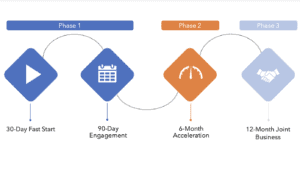Partner Recruiting and Onboarding
Recruiting and onboarding are defining moments early in the partner lifecycle. How you effectively manage those two items will directly impact the success of your partners and your overall program. Recruiting is all about bringing partners to the table, and onboarding is all about getting to revenue with them. You must take the time to recruit the right partners for your program, and then take the time to set them up for success.
Partner Recruiting
Now that your program is in place and you know exactly how you will work with any partner, it’s time to find partners to welcome into your program. Begin by identifying the ways that partners will interact with your solutions. Will they resell, provide managed or professional services, refer, or build solutions around your solution?
Once you have identified the type of partner you will target, the next step is to determine the characteristics of a partner that you seek. Some demographics you may think about are:
- Size and market position
- Vertical markets served
- Existing customer relations
- Complimentary product portfolio
- Partnering commitment
- Company strategy
These are the types of factors you may consider in determining your ideal partner profile. After deciding both your partner type and partner profile, you may want to work with your marketing team to develop a partner recruitment strategy and plan.
Marketing experts will be able to create a focused recruitment campaign with appropriate messaging to the appropriate audience throughout all channels – events, collateral, branding, social media, blogs, webinars and more. As your recruiting campaign starts to generate leads, you can follow up on the potential partner leads, compare their business to your perfect partner profile and decide if they will join your program or not. Providing that they do join, your next step in the partner lifecycle is to onboard them successfully into your program.
Partner Onboarding
Onboarding a partner into your program is a very important series of steps. A full onboarding methodology will cover the period of time until a partner is fully proficient and successful within your program, which could be as long as 1 year or 18 months, depending on your product and program. However, the first 90 days of this process are critical, as research shows that if you don’t properly engage and onboard a partner in the first 90 days of a relationship, your likelihood of success with that partner is greatly diminished.
Onboarding is a process that builds upon itself over time. In the beginning the vendor will spend most of the effort in getting a partner enabled, but over time the effort should level out, and by the end of the onboarding process, the partner will be self-sufficient enough to handle most of the workload themselves.
A Phased Onboarding Approach
Getting to revenue with a partner is directly linked to your onboarding process and how fast you can fully train, enable and start selling with any partner. The good news is that the more effective your onboarding plan is, the faster you can get a partner to the point of revenue. So, moving through the phases completely and efficiently is key to success. Here are a few pointers in developing an onboarding plan:
- Document your plan for your team as well as for your partners to see. It is sometimes helpful to break the plan into manageable chunks of time; where in each bucket of time there are specific tasks to accomplish.
- You should lead with growth in mind, but always have your goals aligned with theirs. Communicating and agreeing on expectations is a great way to reach and exceed individual expectations.
- Yes, please have a conversation about money and goals and be very specific about it. Money is a driving factor in the vendor/partner relationship, so it is important to understand how both sides profit from working together.
- Lastly, establish ownership and accountability at every step in the onboarding process. Make sure action items are clearly documented reviewed and agreed with ownership and due dates. It is important to “do what you say and say what you do” as you establish the framework of a trusted vendor/partner relationship.
Your channel managers may use your onboarding plan to bring new partners into your program, but the onboarding plan can also be modified to introduce a new initiative into the relationship, or when a new employee joins the partner team that person can benefit from all the individual activities in the ramping plan.
Recruiting and onboarding sets the tone for the entire relationship. Taking the time to set things up for success will get you to revenue faster with partners and develop a sustainable revenue stream for years to come.

